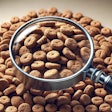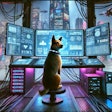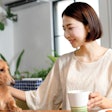Caloric restriction induces body mass loss that is often regained when restriction ends. This study aimed to determine if dietary energy density modulates the extent of post-restriction body mass regain. Water (20%) was added to a commercially available dry cat food and fed to 27 domestic shorthaired cats with a 20% caloric restriction. Following restriction, cats were offered the same dry diet ad libitum either without additional water or with 40% added water, therefore maintaining macronutrient composition while manipulating energy density.
Despite no significant difference in energy intake during ad libitum consumption, post-restriction body mass regain was greater on the high-energy-dense (0% hydrated) vs. the low-energy-dense (40% hydrated) diet.
The same protocol was repeated with a separate cohort of 19 cats with additional measures of physical activity, gut transit time and energy digestibility. Activity levels on the LED diet were significantly higher than in cats on HED diet and were similar to those recorded during caloric restriction. These results suggest body mass gain following caloric restriction is ameliorated and physical activity enhanced by feeding a diet low in energy density from the addition of 40% water.
Source : K.M. Cameron et al., 2010. The effects of increasing water content to reduce the energy density of the diet on body mass changes following caloric restriction in domestic cats. JAPAN online December 2010. doi: 10.1111/j.1439-0396.2010.01107.x


















